Women in the Hindi film industry, both in front of and behind the camera, have broken the "glass ceiling" and have entered every male bastion, actor Raveena Tandon said on Wednesday during a panel of the 'National Conclave on Mann Ki Baat @100'.
Tandon, the star of the 1990 and early 2000s Hindi cinema, said the film industry should learn from sister mediums TV and OTT (over-the-top) platforms, which are the leaders in paying women better and producing shows with female protagonists, respectively, she said.
"We also talk about pay disparity but in the TV industry today, women are paid much higher than their male counterparts, which is a great thing because of the kind of work they do and I think in our TV industry, women rule. In OTT platforms too, the protagonists are mostly women, women's issues are discussed.
"In the film industry, we are going there slowly but surely because it has been a male-dominated industry since the beginning but there is definitely a change. Our women have broken the glass ceiling, we have entered every male bastion...," the 48-year-old actor said, addressing the 'Nari Shakti' session here.
Tandon said issues such as representation and pay disparity still plague the industry but with women in high places, change is on the way.
"... In the world today, there is a change because all the top positions, be it director of photography, our choreographers, our directors, producers, platform heads, and channel heads are women.
"So the opportunities that we should be getting, we are getting that. A woman being at the helm of producing something, she understands those issues, she understands the sensitivity, she has the sensibilities so we get more opportunities," the Padma Shri recipient said.
Tandon, known for films such as Mohra, Daman, Maatr, and web series Aranyak, said in the '90s Hindi cinema actors would "struggle" to break their perceived image.
"There is a lot of change in the film industry that was not there in the 90s. You would get stereotyped for playing a certain character," she said.
The actor, who won the National Film Award for playing a woman subjected to marital rape in the 2001 film "Daman", said her filmography is a reflection of the social causes she supports.
Tandon said issues such as domestic violence and marital rape were brushed under the carpet and she struggled a lot while bringing out a story like "Daman", directed by Kalpana Lajmi.
"I did not get any acceptance and faced a lot of struggle at that time but the film won the National Film Award and rightfully so because it was a film that was ahead of its time. And 23 years later, we are still discussing it (marital rape) even today." The actor also congratulated Prime Minister Narendra Modi and Prasar Bharti on the 100th episode of 'Mann Ki Baat', the monthly radio programme, which is scheduled to be broadcast on April 30.






 Alia Bhatt at the Red Sea Film Festival where she spoke about the scale of Alpha Getty Images
Alia Bhatt at the Red Sea Film Festival where she spoke about the scale of Alpha Getty Images 





